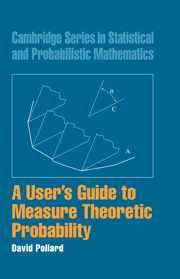Book contents
- Frontmatter
- Contents
- PREFACE
- CHAPTER 1 MOTIVATION
- CHAPTER 2 A MODICUM OF MEASURE THEORY
- CHAPTER 3 DENSITIES AND DERIVATIVES
- CHAPTER 4 PRODUCT SPACES AND INDEPENDENCE
- CHAPTER 5 CONDITIONING
- CHAPTER 6 MARTINGALE ET AL.
- CHAPTER 7 CONVERGENCE IN DISTRIBUTION
- CHAPTER 8 FOURIER TRANSFORMS
- CHAPTER 9 BROWNIAN MOTION
- CHAPTER 10 REPRESENTATIONS AND COUPLINGS
- CHAPTER 11 EXPONENTIAL TAILS AND THE LAW OF THE ITERATED LOGARITHM
- CHAPTER 12 MULTIVARIATE NORMAL DISTRIBUTIONS
- APPENDIX A MEASURES AND INTEGRALS
- APPENDIX B HILBERT SPACES
- APPENDIX C CONVEXITY
- APPENDIX D BINOMIAL AND NORMAL DISTRIBUTIONS
- APPENDIX E MARTINGALES IN CONTINUOUS TIME
- APPENDIX F DISINTEGRATION OF MEASURES
- INDEX
CHAPTER 12 - MULTIVARIATE NORMAL DISTRIBUTIONS
Published online by Cambridge University Press: 29 March 2011
- Frontmatter
- Contents
- PREFACE
- CHAPTER 1 MOTIVATION
- CHAPTER 2 A MODICUM OF MEASURE THEORY
- CHAPTER 3 DENSITIES AND DERIVATIVES
- CHAPTER 4 PRODUCT SPACES AND INDEPENDENCE
- CHAPTER 5 CONDITIONING
- CHAPTER 6 MARTINGALE ET AL.
- CHAPTER 7 CONVERGENCE IN DISTRIBUTION
- CHAPTER 8 FOURIER TRANSFORMS
- CHAPTER 9 BROWNIAN MOTION
- CHAPTER 10 REPRESENTATIONS AND COUPLINGS
- CHAPTER 11 EXPONENTIAL TAILS AND THE LAW OF THE ITERATED LOGARITHM
- CHAPTER 12 MULTIVARIATE NORMAL DISTRIBUTIONS
- APPENDIX A MEASURES AND INTEGRALS
- APPENDIX B HILBERT SPACES
- APPENDIX C CONVEXITY
- APPENDIX D BINOMIAL AND NORMAL DISTRIBUTIONS
- APPENDIX E MARTINGALES IN CONTINUOUS TIME
- APPENDIX F DISINTEGRATION OF MEASURES
- INDEX
Summary
SECTION 1 explains why you will not learn from this Chapter everything there is to know about the multivariate normal distribution.
SECTION 2 introduces Fernique's inequality. As illustration, Sudakov's lower bound for the expected value of a maximum of correlated normals is derived.
SECTION *3 proves Fernique's inequality.
SECTION 4 introduces the Gaussian isoperimetric inequlity. As an application, Borell's tail bound for the distribution of the maximum of correlated normals is derived.
SECTION *5 proves the Gaussian isoperimetric inequlity.
Introduction
Of all the probability distributions on multidimensional Euclidean spaces the multivariate normal is the most studied and, in many ways, the most tractable. In years past, the statistical subject known as “Multivariate Analysis” was almost entirely devoted to the study of the multivariate normal. The literature on Gaussian processes—stochastic processes whose finite dimensional distributions are all multivariate normal—is vast. It is important to know a little about the multivariate normal.
As you saw in Section 8.6, the multivariate normal is uniquely determined by its vector of means and its matrix of covariances. In principle, everything that one might want to know about the distribution can be determined by calculation of means and covariances, but in practice it is not completely straightforward. In this Chapter you will see two elegant examples of what can be achieved: Fernique's (1975) inequality, which deduces important information about the spread in a multivariate normal distribution from its covariances; and Borell's (1975) Gaussian isoperimetric inequality, with a proof due to Ehrhard (1983a, 1983b).
Information
- Type
- Chapter
- Information
- A User's Guide to Measure Theoretic Probability , pp. 274 - 288Publisher: Cambridge University PressPrint publication year: 2001
